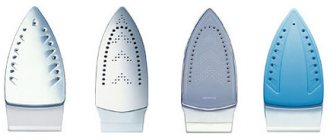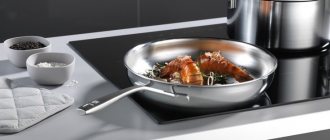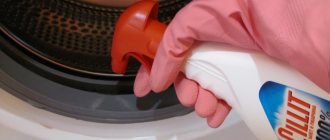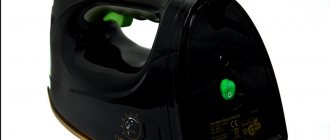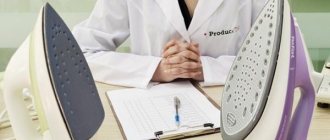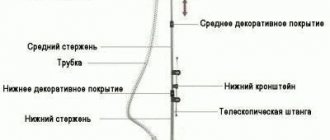Only high-quality iron water can prevent the appearance of drips and yellow spots on clothes. A liquid containing a large amount of salt and calcium impurities can damage the device and also ruin new things. Any equipment owner should know which iron water is suitable for use and which is not advisable to use.
Is it possible to fill?
Distilled water is obtained from ordinary water by distillation or evaporation.
At the same time, all impurities and mineral salts are removed from it. The result is 99% pure water. Therefore , it is believed that it is best used for a steamer.
In irons with this function, water is heated to a high temperature. Because of this, it turns into steam and is supplied under high pressure from special holes on the sole.
But if it contains mineral salts, they precipitate when heated. This is scale. It is deposited on the heating element, clogs the steam holes, and can get on clothes. Therefore, it is necessary to fill the steamer with water that is free of salts.
Reference! Many people believe that the best option is distilled. It definitely won't lead to scale formation.
The best water option for an iron with a steam generator
To prolong the operation of the device, it is necessary to carefully monitor the quality of water and its filtration. The higher the level of cleaning, the higher the service life of the entire structure as a whole, and the quality of ironing in particular.
Experts recommend specially treated water for use:
- filtered, whose composition is cleared of most of the harmful salts and minerals;
- distilled, mixed, in the required proportions, with tap water;
- demineralized - the option is considered the most acceptable, since it maintains the level of steam generation and increases the wear resistance of the iron.
Sometimes it is surprising why some people recommend pouring boiled water into the steam humidifier of an iron, although boiling does not in any way affect the composition of the water. The process is unable to remove salts and minerals from it. In this way, water can only be disinfected, but the consumer is not afraid of infecting a household appliance with an intestinal infection. The problem is different, and in this case boiling will help the steam generator little, or more precisely, it will not help at all.
We recommend:
How to properly iron a leather jacket
Why can't it be used?
But any instructions for the iron say that using distilled water is not recommended. It may seem that this is a marketing ploy to get people to buy irons more often to replace broken ones.
But in reality this is not the case: distilled water has two significant drawbacks that prevent it from being used for a steamer:
- When salts are removed, its physical properties change. It boils at a higher temperature, which also slows down the formation of steam. For the steamer to work on it, the iron must become very hot. This increases the load on the heating elements.
- Distillate without mineral salts has a lower pH level. Because of this, it becomes acidic and can damage the metal elements of the device. With one-time use this is not noticeable, but if you constantly pour distilled water into it, the iron will break faster.
Distilled water
It can be used, but an important factor should be taken into account. This type of water takes longer to reach boiling point. As a result, the iron experiences greater load and wears out faster. Another disadvantage is increased fluidity, due to which water often leaks during the ironing process.
The iron will need to be cleaned every 5-6 months.
Which one is best?
It turns out that pure distillate for a steamer is not recommended , as it will overheat.
But tap water produces scale. To solve this problem, some manufacturers produce irons with special filters that retain salts.
When choosing water for such a device, you must also take into account the quality of tap water. If it is soft, it will not harm the steamer. But to be on the safe side, you can pass it through a filter or mix half and half with distilled water.
How to make distillate at home?
Distilled water is completely free of mineral salts. No filter can do this job. To obtain it, water is passed through a distiller.
But there are several simple ways to get it at home. In essence, such water is condensed steam. Therefore, you just need to bring ordinary water to a boil and collect it.
We recommend an article on the topic
Ways to make distilled water (for drinking and more) at home
What is needed for this?
The easiest way to collect steam is to place a glass under the spout of the kettle and cover the escaping steam with another glass. The only difficulty is that you have to constantly stand next to it, and the glass also gets hot. But you can create a home distiller from simple items that are found in every home.
To do this you will need:
- large wide saucepan;
- a convex lid suitable in size;
- a deep bowl or plate that would fit into the pan;
- ice.
Attention! Distilled water can be stored for a long time in a hermetically sealed container. But for this it is important to wash it properly: there should be no particles of detergent, fibers from rags or drops of tap water left on the walls.
Manufacturing process
The process of preparing distilled water itself is not difficult, although it takes a lot of time, but you do not need to constantly stand nearby or hold something.
A step-by-step guide will help you do everything right:
Pour enough tap water into the pan so that the bowl does not tip over and scoop it up.- Turn on gas and place an empty bowl inside. Cover with a lid, turning it upside down.
- When the water starts to boil, put ice on the lid. It should keep it cool, but you don't need to put in too much, otherwise the melted water will flow over the edge.
When water boils, steam rises and condenses on the cold lid. The drops flow back down the convex surface into the bowl. This condensate is distilled water.
Advice! Before heating, it is advisable to leave the water for 1-2 hours with the lid open so that the chlorine evaporates from it.
How much is needed?
Any ironing device: iron, steamer, steam generator - has clear instructions that must be followed.
Ideally, tanks with a volume of up to 1.5 liters are selected for household use. The water heats up within 5 - 7 minutes; The volume of liquid is enough for about half an hour of ironing. If the number of things is large, water must be added.
After finishing work, some liquid may remain in the tank. It is not recommended to leave it for more than 2 - 3 days. It is better to drain the water, rinse the container and dry it.
Important! Monitor the level of liquid that is added to the tank so as not to damage the device. During refueling, scalding steam escapes through the open cap under pressure. Beware of burns.
How to rinse a water container at home?
You can clean the water container at home if you follow the rules.
- Add 1.5 tablespoons of vinegar or citric acid to a glass of water, pour the mixture into the tank.
- Disable the steam function.
- Connect the device to the network and wait a few minutes.
- Turn off the device and drain the liquid.
How to fill it correctly?
To avoid problems, it is best to use distillate mixed with regular distillate for the device. The proportions depend on the degree of hardness of the water supply.
Most often it is recommended to mix them in equal quantities. If hard water flows from the tap, the percentage of distilled water can be increased.
It is advisable to use distilled tap water. This will help get rid of chlorine compounds. You can also take bottled water instead, which also contains a lot of mineral salts.
The resulting mixture does not lead to scale formation or overheating of the heating element. You can make flavored iron water, similar to the one sold in specialty stores.
To do this, add 40 ml of vodka and 10-15 drops of any essential oil to 300 ml of the mixture. After mixing, refrigerate and can be used within a week. Ironing with this solution will make things smell nice.
What to replace it with?
To maintain the functionality of your iron with a steamer and not spoil your clothes with stains, it is recommended to carefully choose what to put into it:
There is a liquid on sale that is specifically designed for steamers.
It is cleared of salts and other impurities. There are scented and unscented options. It is better to use without fragrances, which can leave marks on the fabric.- You can pass regular tap water through a household filter. It will cleanse it of excess salts, making it suitable for ironing. But its physical properties will not change.
- Demineralized water obtained by deionization is similar in properties to distilled water, so it must also be used in diluted form.
More information about alternative options here.
How does a steamer work and its types?
According to the design features of steam equipment, manual and vertical steamers differ. In terms of the number of functions - single-function and universal.
Based on the principle of action, there are 2 types:
- gravity flow;
- working under pressure.
Important! Gravity steamers are easier to use, but their power is insufficient, so they cannot smooth thick fabrics.
For devices that operate under pressure, the steam supply intensity is very high. Due to this, hot steam penetrates deeply into any fabric and smoothes it well. A special temperature sensor controls the temperature of the steam that comes from the steamer in cycles.
A vertical steamer can also be used to disinfect various surfaces, toys, etc.
A steam generator is similar in appearance to an iron, but it smoothes fabrics much more effectively. Everything can be treated, from curtains made of delicate fabrics to upholstered furniture and carpets. Has a conditioning effect. This is a very convenient device for maintaining trouser suits, down jackets and fur coats in good condition.
Produces very hot steam. The temperature of the steam, which is released under high pressure, reaches 140 - 160°.
Steam generators are produced in an assortment and are also divided into types:
- manual;
- floor;
- combined.
Interesting! The quality of work depends on the power of the device: the more powerful, the better it copes with the task. The kit may include various attachments that help simplify the use of the device.
Manual steam generators have a number of advantages:
- compact, mobile, lightweight;
- affordable;
- Convenient for frequent use at home and when traveling.
Some cons:
- insufficient power for processing dense fabrics;
- operating time is about 20 minutes.
Floor-standing structures are equipped with large tanks, have high power, but take up a lot of space and are quite expensive.
Combined steamers are similar in functionality: they can be used not only for ironing, but also for cleaning and disinfection. The prices are also high, but they are reliably justified.
Do you have a steam generator?
Not really
Which device should you choose?
Modern industry produces other types of steaming devices:
- steam cleaners – good for cleaning curtains;
- steamers with wet steam;
- functional irons with a steamer (steam generation);
- steam mops.
Advice! Steam generators with hard soles are more suitable for ironing clothes. The greatest effect from ironing is achieved by steam generators that supply 120 - 150 grams of steam per minute to the treatment surface.
When choosing a device, you should focus on well-known brands. Although steamers and steam generators are somewhat different in purpose, both supply steam that is generated from water.
In accordance with the instructions, you can fill the tank with water from the tap. But it doesn’t always differ in quality; not every one is suitable for use. This article will tell you which steam generator is best to choose for your home. Also learn about the design and operating principles of a steam generator.
